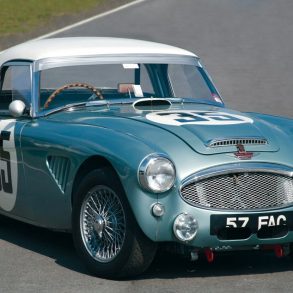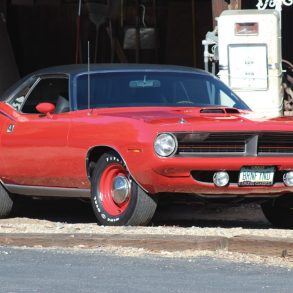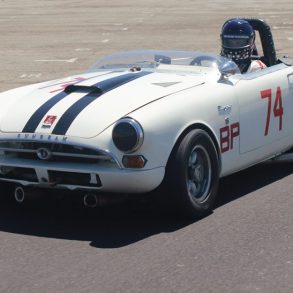In late 1967, the new and much lighter Escort was forecast to be the most suitable model in the Ford range to replace the aging Cortina, which in Mk1 and Mk2 Lotus-badged guise had

To withstand the long distances and high altitudes of the Andes during the 1970 London to Mexico Rally, a rugged but simple push-rod motor of 1850cc capacity was developed for the works Mexico Escort entries which went on to dominate the leader board of the South American Marathon. The marketing spin-off Mexicos in the local Ford showroom were duly fitted with 1600cc ‘Kent’ engines of similar design though lower cost.
For the other major rallies, where the special stages were shorter and very much more power was required, both the factory team Escorts and therefore the FIA-policed run of ‘Production’ cars built by Advanced Vehicles Operations at Aveley soon gained ‘Cosworth BDA’ Ford-based engines (produced by the Northamptonshire firm of former Lotus and Ford engineers Mike Costin and Keith Duckworth of FVA F2 and DFV F1 engine building fame, the new engine so called because of being a ‘Belt Driven version A’). These Cosworth 4-cylinder engines with belt-driven double overhead-camshafts and 16-valves powered the production Escort RS1600 between 1968 and 1972. During this period BDAs in works cars went from being 1558cc and larger with a steel block to having a Brian Hart developed alloy-block of 1993cc capacity by mid-1972, whilst progressive modifications saw the power output increasing to 230bhp.

The well over 3000 miles route, which started and finished at Easter in the Tanzanian capital Dar Es Salaam, took 83 of the best prepared rally cars in the world inland over the back roads to Nairobi in Kenya, then via the Ugandan capital Kampala to Mombasa on the coast in Kenya on a rock-strewn epic through the East African outback. So demanding were the terrain and conditions encountered, which included choking dust clouds, suspension crunching boulders, car swallowing potholes, rainy season downpours of car wash proportions, slithery red mud and brushes with unpredictable wildlife, that only 18 cars and crews survived what is generally reckoned not only to have been the toughest Safari motor rally ever staged.
Flagged away by Tanzanian President Julius Nyerere, Scandinavians Hannu Mikkola and Gunnar Palm in RWC 455K led from the off and were only really challenged by teammates Timo Makinen and Henry Liddon in RWC 456K, which although suffering mechanical problems eventually finished 8th. Flying Finn Mikkola’s winning margin in RWC 455K over the second placed Zazada/Bien Porsche 911 was an impressive 28 minutes, whilst the sister cars RWC 458K and REV 119K driven by locals Vic Preston and Robin Hillyer finished 3rd and 4th respectively. Joginder Singh in RWC 457K was among the 65 competitors who failed to make the Dar Es Salaam finish in time.
Mikkola’s victory in RWC 455K, well charted in Nick Brittan’s book and in a film record of the event introduced by World of Sport’s Dickie Davies as well as countless press reports at the time, also well and truly smashed the myth that had built up since the Coronation Rally in 1953, the start of this annual motoring adventure, that a European driver would never be able to win the African classic.
Following Ford Motor Company ownership, from 1975 the car belonged to City Speed of Gloucester from whom it was acquired by a Mr Sagoo in 1978. More recently, other owners have included Alan Anderson and then M-Sport chief and former Ford works driver Malcolm Wilson from whom the current owner directly acquired the car in February 2008. All the ex-works numbers are confirmed on both car and V5C while MOT certificate and tax disc are also valid.
Unlike so many of the major Escort competition cars of the period – which were exhaustively campaigned for many more seasons and extensively rebuilt and re-shelled as a result, losing many of their major components along the way – RWC 455K was never rallied again by Ford and therefore originality has been retained. Today, this famous motor car is very much just as it crossed the Safari finish line with Boreham-specification 1850cc steel-blocked BDA engine (rebuilt in December 2007), ZF 5-speed gearbox and Atlas axle all still present. The East African mud and dust may well have been hosed off the 2-door bodywork long ago, but the livery from that great victory in 1972 remains in place on what is one of the most historically important of all the Mk1 Escorts.
The Ford Escort RS1600 that Hannu Mikkola and Gunnar Palm piloted to victory at the 1972 East African Safari Rally did not meet the minimum reserve at Bonhams’ Collectors Motor Cars and Automobilia sale held July 3rd, 2009 at the Goodwood Festival of Speed in England. Its pre-sale estimate was £90,000 – 110,000.
[Source: Bonhams]











nicce